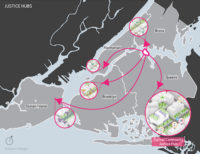Some three years after hurricanes Katrina and Rita swept through the Gulf of Mexico, temporary housing provided by the Federal Emergency Management Agency (FEMA) remains in the news. Earlier this month the Centers for Disease Control and Prevention reported dangerously high levels of formaldehyde in some of the thousands of FEMA trailers sent to the Gulf, adding urgency to the agency’s efforts to resettle victims. As the fallout continues, federal and state agencies are weighing new approaches to emergency shelter.
FEMA’s Alternative Housing Pilot Program (AHPP), authorized by Congress in 2006, provides $400 million to Gulf states for the development and testing of new forms of emergency shelter, some of which is designed to form the basis of permanent housing. The alternative shelters represent a rethink of the standard-issue FEMA trailers, which were typically deployed in isolated camps, cut off from the communities they were meant to revive. Projects such as the Katrina Cottage and the Green Mobile emphasize modular construction, mobility, and sustainability. Some AHPP prototypes also address community building.
Several thousand people, of the hundreds of thousands displaced by the 2005 storms, are living in these new dwelling types. The Department of Housing and Urban Development (HUD) is sponsoring a pair of tracking studies of them: one, conducted by the National Association of Home Builders (NAHB), to assess the performance of the structures and materials; the other, conducted by Abt Associates, to monitor how well people are served by the various designs.
“This is the first significant, serious, systematic effort to look objectively at alternatives to the way we’ve handled disasters in the past,” says Mike Luzier, president of the NAHB Research Center. “We’re saddened by the collective response to the [2005] disaster. It’s galvanized government and industry.”
The research aims to estimate the long-term benefits of the emergency shelters, says Dana Bres, a HUD research engineer coordinating the studies. “Will the homes actually contribute to the community coming back? We’re looking at how these can be integrated into permanent homes.”
The NAHB study will evaluate the alternative structures’ durability, indoor air quality, energy use, as well as resistance to pests, UV radiation, and moisture, explains project manager John Peavey. Abt Associates, meanwhile, will survey residents to assess the quality of life in the units, according to company economist Larry Buron.
Depending on the size, type, and grouping of units in a given project, Buron says, “We’re going to ask things like, ‘Were you able to regroup as a family because you’ve got a larger unit, or access to services?’ and, ‘Will the transition be smoother if residents sense [the shelter] is permanent?” Abt Associates will also rate the units’ physical accessibility.
Although HUD’s research is expected to improve emergency response nationwide, critics have noted disparities in the distribution of pilot project money. Mississippi, Louisiana, Texas, and Alabama garnered funding, with Mississippi securing a hefty $280 million of the $400 million total. Critics suggest that Mississippi Governor Haley Barbour, the former chairman of the national Republican Party, was in a position to lock up more than his state’s share. FEMA officials, though, say that awards were based on the merits of each proposal and that an internal investigation found no undue political influence.
Both studies began last fall and will run for 42 months. HUD will report their findings to Congress and FEMA. The NAHB is also working with the National Building Museum to exhibit AHPP-sponsored work.



